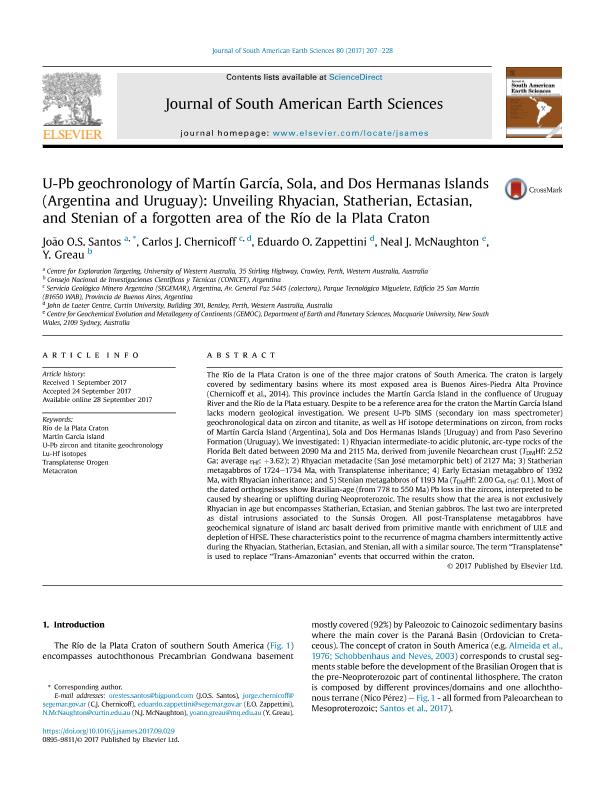Artículo
U-Pb geochronology of Martín García, Sola, and Dos Hermanas Islands (Argentina and Uruguay): Unveiling Rhyacian, Statherian, Ectasian, and Stenian of a forgotten area of the Río de la Plata Craton
Santos, João O. S.; Chernicoff, Carlos Jorge ; Zappettini, Eduardo Osvaldo; McNaughton, Neal J.; Gréau, Yoann
; Zappettini, Eduardo Osvaldo; McNaughton, Neal J.; Gréau, Yoann
 ; Zappettini, Eduardo Osvaldo; McNaughton, Neal J.; Gréau, Yoann
; Zappettini, Eduardo Osvaldo; McNaughton, Neal J.; Gréau, Yoann
Fecha de publicación:
12/2017
Editorial:
Pergamon-Elsevier Science Ltd
Revista:
Journal of South American Earth Sciences
ISSN:
0895-9811
Idioma:
Inglés
Tipo de recurso:
Artículo publicado
Clasificación temática:
Resumen
The Río de la Plata Craton is one of the three major cratons of South America. The craton is largely covered by sedimentary basins where its most exposed area is Buenos Aires-Piedra Alta Province (Chernicoff et al., 2014). This province includes the Martín García Island in the confluence of Uruguay River and the Río de la Plata estuary. Despite to be a reference area for the craton the Martín García Island lacks modern geological investigation. We present U-Pb SIMS (secondary ion mass spectrometer) geochronological data on zircon and titanite, as well as Hf isotope determinations on zircon, from rocks of Martín García Island (Argentina), Sola and Dos Hermanas Islands (Uruguay) and from Paso Severino Formation (Uruguay). We investigated: 1) Rhyacian intermediate-to acidic plutonic, arc-type rocks of the Florida Belt dated between 2090 Ma and 2115 Ma, derived from juvenile Neoarchean crust (TDMHf: 2.52 Ga; average εHf: +3.62); 2) Rhyacian metadacite (San José metamorphic belt) of 2127 Ma; 3) Statherian metagabbros of 1724–1734 Ma, with Transplatense inheritance; 4) Early Ectasian metagabbro of 1392 Ma, with Rhyacian inheritance; and 5) Stenian metagabbros of 1193 Ma (TDMHf: 2.00 Ga, εHf: 0.1). Most of the dated orthogneisses show Brasilian-age (from 778 to 550 Ma) Pb loss in the zircons, interpreted to be caused by shearing or uplifting during Neoproterozoic. The results show that the area is not exclusively Rhyacian in age but encompasses Statherian, Ectasian, and Stenian gabbros. The last two are interpreted as distal intrusions associated to the Sunsás Orogen. All post-Transplatense metagabbros have geochemical signature of island arc basalt derived from primitive mantle with enrichment of LILE and depletion of HFSE. These characteristics point to the recurrence of magma chambers intermittently active during the Rhyacian, Statherian, Ectasian, and Stenian, all with a similar source. The term “Transplatense” is used to replace “Trans-Amazonian” events that occurred within the craton.
Archivos asociados
Licencia
Identificadores
Colecciones
Articulos(SEDE CENTRAL)
Articulos de SEDE CENTRAL
Articulos de SEDE CENTRAL
Citación
Santos, João O. S.; Chernicoff, Carlos Jorge; Zappettini, Eduardo Osvaldo; McNaughton, Neal J.; Gréau, Yoann; U-Pb geochronology of Martín García, Sola, and Dos Hermanas Islands (Argentina and Uruguay): Unveiling Rhyacian, Statherian, Ectasian, and Stenian of a forgotten area of the Río de la Plata Craton; Pergamon-Elsevier Science Ltd; Journal of South American Earth Sciences; 80; 12-2017; 207-228
Compartir
Altmétricas



